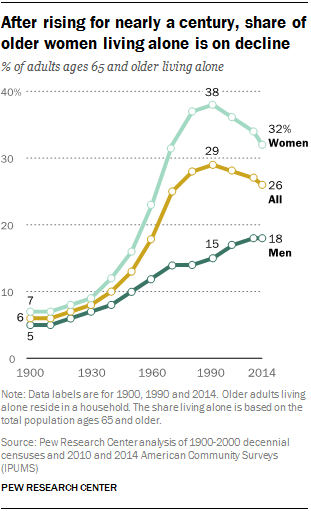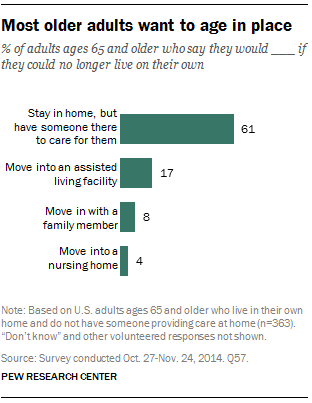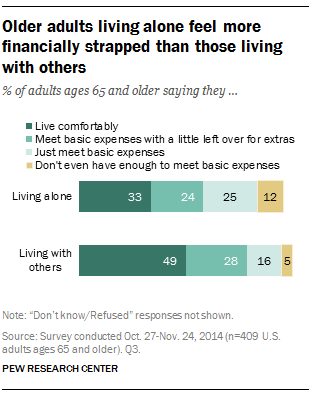
After rising steadily for nearly a century, the share of older Americans who live alone has fallen since 1990, largely because women ages 65 to 84 are increasingly likely to live with their spouse or their children. The likelihood of living alone has grown since 1990 for older men and for women ages 85 and up.
Between 1900 and 1990, the share of adults ages 65 and older living alone increased nearly fivefold, from 6% to 29%. This growth was spurred by a host of factors, including improved health and longevity among older Americans and the economic security that came with social safety net programs such as Social Security and Medicare. 1
One explanation for this trend is that an increase in life expectancy, especially among men, has made it more likely that older women would be living with their spouses rather than as widows.
[tweetable url="http://pewrsr.ch/1KqN9kZ" alt="Among women ages 65 to 84, the share living alone declined by 8 percentage points since 1990, reaching 30% in 2014"]Older men ages 65 to 84, on the other hand, are somewhat less likely to live with a spouse now compared with 1990, though most still do. Living arrangements for men in this age group have grown more diverse as a rising share have divorced and not remarried.

Overall, women still make up a majority of the 12.1 million older U.S. adults living alone, but their share has fallen significantly over the past quarter century – from 79% in 1990 to 69% in 2014.
[tweetable url="http://pewrsr.ch/1KqN9kZ" alt="61% of older adults say they would have someone care for them in their own home if they could no longer live alone"]
In some ways those who live alone also feel somewhat more socially isolated. A Pew Research Center survey conducted Feb. 23-March 23, 2009, among 2,969 U.S. adults (including 1,328 adults ages 65 and older who responded to questions about their living arrangements) found that older adults living alone are less likely than older adults who live with others to say that, as they’ve aged, they have more time with their family. And men who live alone (but not women) are less satisfied with the number of friends they have than are men who live with others. However, older adults who live alone and those who live with others are equally likely to say they receive the right amount of help from their children.
This report uses U.S. Census Bureau data to describe trends in living arrangements among older adults over the past 25 years, focusing on differences in gender and age.
Using data from Pew Research Center surveys, the report also analyzes the well-being of older Americans who live alone, looking at their economic status, their satisfaction with key aspects of their lives, and their relationships with their children and grandchildren.
Other key findings:
- The [tweetable url="http://pewrsr.ch/1KqN9kZ" alt="Americans ages 85 and older living in nursing homes or other group quarters declined from 24% in 1990 to 11% in 2014"]share of Americans ages 85 and older living in nursing homes or other group quarters has declined dramatically. In 2014, 11% lived in a nursing home or other group quarter – down from 24% in 1990. This decline has been met with an increase in a variety of other living arrangements, including living alone or living with a spouse or child.
- Older women who live alone are more likely than men to say they spend more time on their hobbies. Fully 65% of women who live alone say they spend more time on their hobbies and interests as they age, compared with 49% of men.
- Older adults living alone are also in less frequent contact with their children and grandchildren than adults who live with others. 2 Among older adults with grandchildren, 43% who live alone say they are in contact with their grandchildren on at least a weekly basis, compared with 60% of those living with others.
“Older adults” is used throughout this report to describe adults ages 65 and older.
“Living alone” refers to people who live in their own homes, not in group quarters. Group quarters are places where people live in a group arrangement, which is owned or managed by an organization that provides housing and/or services for their residents. Group quarters include nursing homes, in-patient hospice facilities, mental hospitals, group homes and other institutional and non-institutional living arrangements. Generally, assisted-living facilities are not defined as group quarters. Therefore, individuals who live in an assisted-living facility unit may be counted as living alone if there are no other residents in their unit. For more details see: https://www.census.gov/popest/about/terms/housing.html
“Married, living with spouse” includes only those who are married with a spouse present in the household. Those who are married, but the spouse is absent from the household are grouped with “unmarried” adults. Individuals who are married and living with a spouse may also live with other relatives or non-relatives.
“Unmarried” adults are those who are separated, divorced, widowed or have never been married. This group also includes adults who are married, but the spouse is absent from the household.




